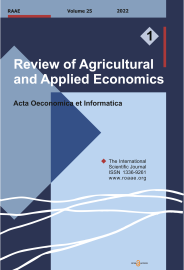KEYWORDS:
Asymmetric price control, Intermediaries, Local millet, Mali, Price transmission
DOI NUMBER:
10.15414/raae.2020.23.01.3-12
ABSTRACT:
Commodity prices consistently increase in developing countries while they barely decline, affecting negatively poor and vulnerable people. This paper examines the role of intermediaries such as collectors, wholesalers, and retailers in the asymmetric transmission of millet prices from producers to consumers in local millet markets in Mali. We use data of local millet prices from the five most important cities in terms of local millet production in Mali namely; Bamako, Segou, Kayes, Koulikoro and Sikasso. Using the Threshold Auto-Regressive (TAR) method developed by Enders and Siklos (2001), at the exogenous threshold, we found an asymmetrical transmission between Koulikoro and Ségou collectors’ market. The result shows that, collectors in Koulikoro promptly transmit price increases while they lately transmit price decline at exogenous threshold. Strong evidence was found to suggest that, collectors in Koulikoro and wholesalers in Sikasso punctually transmit a decrease in millet prices to consumers while they tardily transmit the increase in prices to consumers even though the effect of prices increment are relatively larger than the effect of price decrease at endogenous threshold. By applying a zero exogenous threshold we found a non-asymmetric cointegration between Kayes and Ségou, Sikasso and Ségou ‘collectors market and between Sikasso and Ségou wholesalers’ market. Regardless of the threshold chosen in retailers market, we found symmetric prices transmissions between all the markets pairs. In order to reduce this asymmetric price transmission and to fight against poverty, the authors suggest that decision-makers should consider introducing millet price control in the local markets, especially when millet prices increase spontaneously.
Please Cite this Article as:
Alou DEMBELE, Ahmet ÖZÇELİK, Ernest OUEDRAOGO, Lamissa DIAKITE (2019) Intermediaries And Asymmetric Pricing. Evidence From The Market Of Local Millet In Mali. Review of Agricultural and Applied Economics. XXIII (Number 1, 2019): 3-12. doi: 10.15414/raae.2020.23.01.3-12
URL for sharing:
http://roaae.org/1336-9261/doi/abs/10.15414/raae.2020.23.01.3-12
FULL TEXT PDF:
▼ direct download link| view online in fullscreen ▲
References:
▼ direct download link

